 Image search results - "festival," Image search results - "festival," |
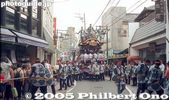
Held in July, Narita Gion Matsuri Festival has ornate floats pulled on the streets of Narita and to Narita-san temple. Pulling a float on the street
|
|

From late April to early May, five long strings of giant carp streamers swim in the air high above the Sagami River in Sagamihara, Kanagawa. This event was started in 1988.
|
|

The biggest taiko drum festival in the Kanto region is held annually in April. Various taiko drum troupes perform for two full days on various outdoor stages in Narita, including the main stage in front of the Narita-san temple.
|
|

One of two giant kitesThis festival has two giant kites and two smaller (but still large) kites. Resting on its side, the kite was scheduled to fly at 2 pm. The kanji characters read "Michi no Eki" in reference to a new train station built in the town.
|
|

Festival's focal pointThis grass hut is at the center of the festival site which is within the Sakitama Tumuli Park. It will be burned later in the evening for the festival's climax.
|
|

Pulling the float, Narita Gion Matsuri
|
|

There are five rows of streamers. In Japan, the koi carp is regarded as a symbol of valiant manhood because it swims up the river against the rapids.
|
|
|
|
|

Offerings
|
|

Tired from walking, Narita Gion Matsuri
|
|

The cable length is 250 meters and 13mmm thick. There are about 1,200 carp streamers. They are reused every year and donated by local families. (I also noticed a few advertising carps.)
|
|
|
|
|

Festival siteIt is a circular site with people sitting along the perimeter.
|
|
|
|
|
|

Lowering the kite
|
|

SpectatorsThese people are sitting in the best area to view the festival.
|
|
|
|
|
|

EntertainmentAn outdoor stage provides a variety of entertainment during the day.
|
|
|
|
|
|
|

Festival participantsThey are dressed in the costume of the ancient Kofun (Tumuli) Period of Japan. They will be carrying torches from the nearby tumuli.
|
|

Sagami River Koi-nobori
|
|
|
|

Patch up
|
|

TumulusCherry trees are at the top.
|
|
|
|
|
|
|

Shinto ceremonyAt around 6:30 pm, the festival climax starts.
|
|
|
|
|
|

Moving the kite to launch point
|
|

Torch bearers enter
|
|
|
|
|
|

Festival siteThey did not allow people go enter the launch area at all times. Spectators were kept far away.
|
|

Marvelous spectacle
|
|

The longest carp is 10 meters.
|
|

Narita Gion Matsuri
|
|
|
|
|
|

Parade aroundThe torch bearers parade around the entire perimeter before they gather around the hut.
|
|
|

Narita Gion Matsuri
|
|
|

No people on the sides either
|
|
|

Along the river were food stalls.
|
|
|
|

Launch point on a low hill
|
|

Male prince
|
|

Festival site
|
|
|
|

Cable anchor
|
|
|

Female princess reigning over the Sakitama Fire Festival in Gyoda, SaitamaShe's 15 years old.
|
|
|
|
|
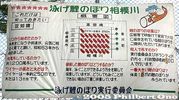
Statistics
|
|
|
|
|
|

Side entrance to Narita-san temple.
|
|
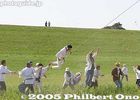
Ride'em cowboyAs the kite quickly flew up, the forward kite pullers had to release the rope.
|
|

Torch lightingThe prince and princess light the torch that will ignite the hut.
|
|
|
|
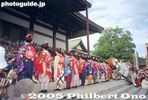
Offering prayers at Narita Gion Matsuri
|
|
|

Climax
|
|
|
|
|
|
|
|
|
|
|
|

Gathering at Narita-san temple
|
|
|

Michi no EkiThe kite design is the same every year, but the kanji characters change. They make a new giant kite every year.
|
|

Torch bearers from the tumulus
|
|

Prayers at Narita-san
|
|
|
|
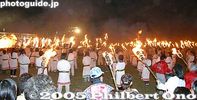
Stage ceremonyThe torch bearers gathered in front of the stage where there were speeches and cheers.
|
|

Narita Gion Matsuri
|
|
|

FireworksThe festival ended at 7:30 pm.
|
|
|
|
|
|
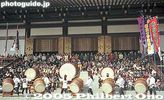
Main stage at Narita-san temple.
|
|
|
|
|
|
|

Smaller kite "Yujo"
|
|
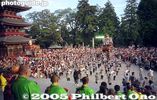
Narita-san during Narita Gion Festival
|
|
|
|
|
|
|
|
|

Main stage at Narita-san temple.On Saturday evening, the festival climaxes with a free show on the main stage. The best taiko troupes from Japan and overseas performed for 2 hours.
|
|

"Yujo"This is a smaller kite. It means "Friendship."
|
|
|
|
|
|
|
|
|

Narita Gion Matsuri
|
|
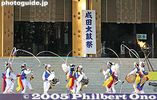
Drum troupe from S. Korea
|
|
|
|
|
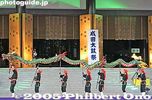
Taiko troupe from OkinawaThis group stole the show with a dragon dance, lion dogs, and eisa taiko drummers.
|
|
|
|

She fell
|
|
|
|

Patch up
|
|
|
|
|
|
|
|

"Nakama"This is another smaller kite. It means "Circle of Friends."
|
|
|
|

Anchor truck
|
|
|

Amateur areaFurther downwind was the amateur area for flying normal kites.
|
|
|
|

Another launch
|
|
|
|

Last group
|
|
|

Another beautiful take off
|
|
|
|
|
|
|
|

Poster
|
|

Mud Paddy. Main site of the Warabi Hadaka Matsuri held every Feb. 25.
|
|
|

Preparing for the seaDuring a break, the mikoshi is prepared for a run in the ocean.
|
|
|
|
|
|
|
|
|
|

Water's edge
|
|

Down ramp
|
|
|
|

At seaShrine helpers on a boat splash buckets of sea water on the mikoshi bearers.
|
|

Blessings at seaThe mikoshi and bearers are blessed by a shrine priest on a boat wielding a sacred staff.
|
|
|
|
|
|
|
|
|
|
|

Mikoshi made of acorns
|
|

Crossing over
|
|
|
|
|

Passing Enoshima Station
|
|

Passing by Ryukoji Temple
|
|

Mikoshi face-offThe shrine from Yasaka Shrine on Enoshima is the male (left), and the mikoshi from Koyurugi Shrine (foreground) is female.
|
|

Tram breakPart of the procession route also happened to be the Enoden streetcar route so we had to make way for the passing streetcar every 15 min. or so. There were streetcar personnel who blew their loud whistles whenever a streetcar was to pass through. I got scolded for sticking out my head to take this shot.
|
|
|

Streetcar break
|
|

Parading along a shopping street
|
|
|

KnockersWhen they carry the mikoshi, a pair of knockers on both sides the mikoshi are struck to make a rhythmic sound.
|
|

Mimusubi Shrine, Yotsukaido, Chiba. The small shrine that conducts the festival. (皇産霊神社)
|
|

Baby Blessings at Warabi Hadaka Matsuri in Yotsukaido, Chiba. Infants are blessed in front of the shrine.
|
|

Men Take Strands of Straw
|
|

A Man and a Baby at Warabi Hadaka Matsuri in Yotsukaido, Chiba.
|
|

Babies to Mud at Warabi Hadaka Matsuri in Yotsukaido, Chiba. The men carry babies to the mud paddy and use a straw strand to paint a dot on the baby. Sometimes they use a finger to do it.
|
|
|
|
|

Sacred Water (and Mud). On the the left, the water feeding the paddy is enclosed by a sacred rope. This makes the water (and mud) sacred.
|
|

All the baby-carrying men must be careful not to slip and fall in the mud. Warabi Hadaka Matsuri in Yotsukaido, Chiba.
|
|

Mud Spotting, Warabi Hadaka Matsuri in Yotsukaido, Chiba. The men hold babies and use mud to paint a mud spot on the baby's face. It is to wish for happiness for the baby.
|
|

Some babies wear beautiful kimono for the occasion.
|
|

The festival is also nicknamed "Doronko Matsuri" which means Mud Festival.
|
|

Mud Fight
|
|

Keep in mind that this is in the middle of winter.
|
|
|

Mud Fight. After clashing and crashing to the mud, they throw mud at each other.
|
|

They are in the mud for only a few minutes. Then they go back up to the shrine nearby and warm up near a fire. They go back and forth between the shrine and mud paddy about 4 or 5 times.
|
|

A Touch of Mud. One custom is to receive a touch of mud on your face.
|
|

Mud for All Ages
|
|

Mud Brings Happiness, at Warabi Hadaka Matsuri in Yotsukaido, Chiba.
|
|

New Status Symbol at Warabi Hadaka Matsuri in Yotsukaido, Chiba.
|
|

Mud on Your Face: Fashionable, at Warabi Hadaka Matsuri in Yotsukaido, Chiba.
|
|

After warming up at the fire, they run back to the mud.
|
|

Mud Fight Round 2
|
|
|
|
|

Mud Slinging
|
|
|
|

I can't see... That's what he said: "Mienai" The kids nearby were screaming with laughter.
|
|
|

Warm Up
|
|
|

The End(s)
|
|
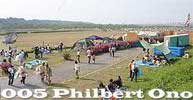
The following photos were taken on May 5, 2005. The site is on a baseball field, very dusty. The site is directly south and downstream from the Sagamihara kite festival site.It was a great idea to hold both kite festivals on the same days. We could see both in one day.
|
|
|
|
|
|

Corner rope work
|
|
|
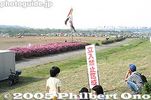
Do not enter sign. In 2004, on a very windy day (almost typhoon strength), Zama's giant kite broke in the air and crashed to the ground onto spectators (who got hurt) on the side, right beyond the carp streamers in this picture. So from 2005, they have become very strict and cordoned off the area where the kite crashed.
|
|

Ready and all clear
|
|
|

Lift off despite weak winds
|
|
|
|
|
|
|

Zama's kite apparently was lighter than Sagamihara's kite because it went up much higher under the same wind conditions.
|
|

The kite pullers can only run so far (about 50 meters or so). After that, if the wind doesn't kick in, the kite falls back down.
|
|
|

Rope anchor
|
|

Rope anchor
|
|

Entertaiment
|
|
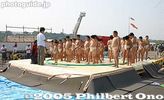
Children's sumo. Zama had a variety of side events.
|
|

Disassembly
|
|
|
|
|